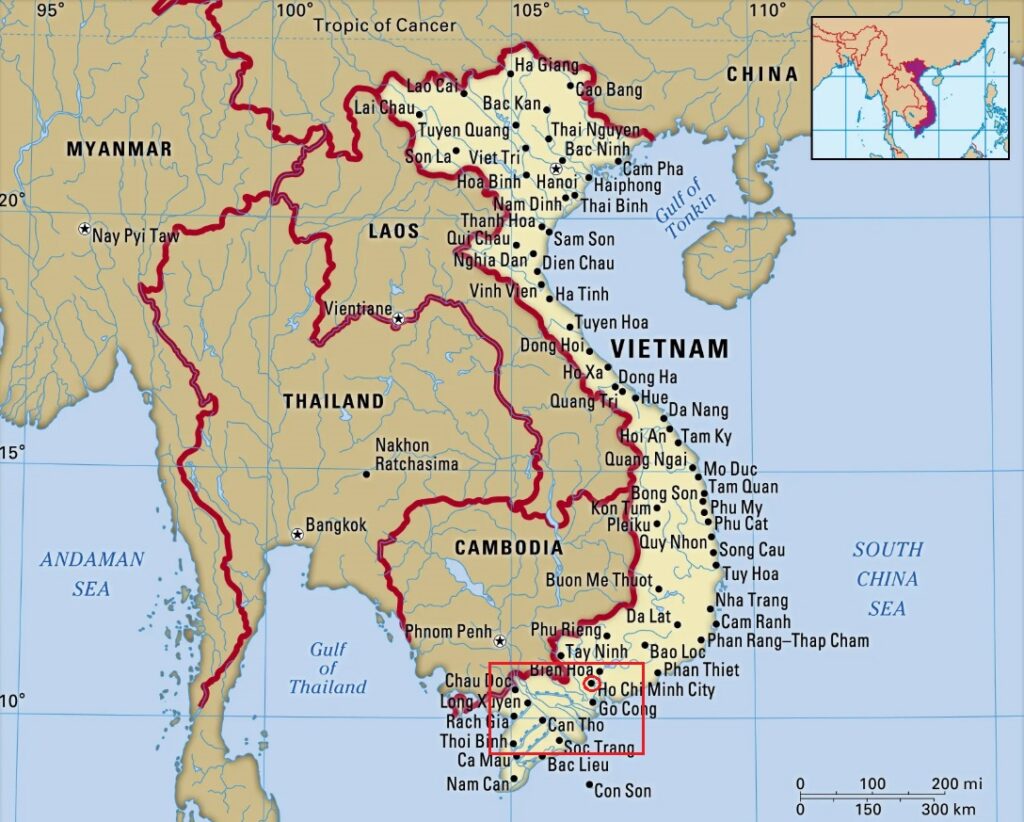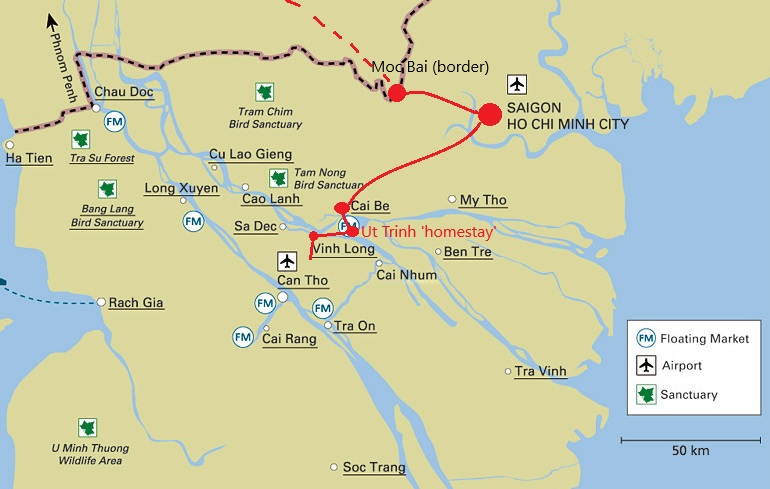

Mekong River Delta
The Mekong Delta is located in the west of Ho Chi Minh City, roughly forming a triangle stretching from My Tho in the east to Chau Doc and Ha Tien in the northwest, down to Ca Mau and the East Sea at the southernmost tip of Vietnam.
The Socialist Republic of Vietnam, is a country with over 100 million people. Its capital is Hanoi and its largest city is Ho Chi Minh City (commonly known as Saigon). Vietnam’s land is mostly hilly and densely forested, with level land covering no more than 20%. Mountains account for 40% of the country’s land area, and tropical forests cover around 42%. The Mekong River Delta in the south covering about 40,000 km2 is crisscrossed by a maze of rivers and canals.
Vietnam’s history goes back thousands of years. From about 1500 Portuguese and French traders and missionaries started to settle on the coast of Vietnam, and in 1883 the territory was integrated into French Indochina. After World War II ended in 1945 the nationalist Viet Minh led by the communist Ho Chi Minh fought with France in the First Indochina War In 1946 to 1954. The Vietnam War began in 1955 between the communist North and the anti-communist South. In 1975, Vietnam reunified as a unitary socialist state under the Communist Party of Vietnam in 1976.
I visited Vietnam in November 2024 in connection with a Vietnam-Cambodia tour. After visiting a market and other sights in Saigon we had a very enjoyable scooter & dinner tour. With about 12-13 million people in the Saigon area and 9 million scooters the traffic with was surprisingly smooth. We also visited one of the ‘killing fields’, the Vietcong tunnels and the war museum. Before heading for Cambodia we had a few very nice days in a ‘homestay’ in the Mekong River Delta with sightseeing trips.
Day 2: Binh Tay Market, Saigon, November 2024
On our first morning after arriving in Saigon we started our city sightseeing with a visit to the Binh Tay market. The market is one of the earliest surviving structures in the city and an important symbol. It is one of the largest markets in Saigon and a major business hub not only for the local Vietnamese and Chinese, but also for the Vietnamese farmers trading daily goods coming from all directions of South Vietnam. The construction of Binh Tay Market commenced in 1928 and was successfully completed in 1930. It’s architecture combines Chinese influences with French construction techniques, and is shaped like a bagua, a symbol from Chinese culture representing harmony and balance. At the heart of the market lies a refreshing courtyard as a tranquil oasis.
Day 2: Thien Hau Temple, Saigon, November 2024
The Thien Hau temple, officially the Tue Thanh Guildhall, is a Chinese-style temple of the Chinese Goddess of Sea, Mazu in Chinatown in Saigon. The temple was first erected ca. 1760 by the Cantonese community in the city, with several major repairs or expansions between 1800 and 1916.
The interior of the temple is a partially covered courtyard with the altar to Mazu at the end. The exposed portions of the courtyard contain incense burners, and open the view to the remarkable porcelain dioramas that decorate the roof. The dioramas show scenes from a 19th-century Chinese city, and include such colorful figures as actors, demons, animals, and Persian and European sailors and traders.
Day 2: more sightseeing in Saigon, November 2024
After visiting the Thien Hau temple we continued to the Independence Palace, the old post office, and after lunch the War Remnants Museum. Not very interesting for me, therefore not much video.
The palace was built for the president in 1962 to replace the old palace – simply a very large modern building in a park. The old post office was constructed when Vietnam was part of French Indochina completed in 1891 with Gothic, Renaissance and French architecture, and is now a tourist attraction crowded with tourists buying souvenirs. The War Remnants Museum contains exhibits relating to the First Indochina War and the Vietnam War. Photo/video was not allowed inside, but there was a good collection war of aircrafts outside.
Day 2: Scooter Dinner Tour, Saigon, November 2024
In the evening we were having a scooter adventure tour in Saigon with stops for drinks and dinner. Each of us was assigned a Vespa scooter with an experienced driver. After the first 5 minutes in the chaotic traffic I relaxed because there was a system in the chaos. Everyone was flexible. First stop was for a drink on a rooftop bar with fantastic view of the city. After another wild drive through the streets we stopped at the first restaurant, and a little later at the second. Fully stuffed with very tasty food we spent some time in a basement bar with an orchestra playing latin/salsa music before returning to our hotel.
Holding onto the scooter and filming with one hand only with a compact camera was not easy!
Day 3: Vietcong Tunnels, Củ Chi, Saigon, November 2024
In the morning we visited the Củ Chi-tunnels – the immense network of connecting tunnels located in the Củ Chi District of Saigon that are part of a much larger network of tunnels that underlie much of the country. The Củ Chi tunnels were constructed during the Vietnam War, and served as headquarters for the Viet Cong during the operations for the Offensive in 1968.
We had lunch in a restaurant in the Củ Chi area before returning to our hotel in Saigon center.
Day 3: Dinner Cruise, Saigon, November 2024
In the evening we were bussed through very slow traffic in Saigon center to the dinner cruise ship Indochina Queen, one of several restaurant ships – a large ship with lots of decorations and lights, many guests, excellent food and local entertainment. During dinner we sailed a short distance on the Mekong River before returning to the dock.
Being Saturday evening, with a closed road in the center, the traffic was even worse. Hundreds of scooters passed our bus.
Day 4: Arrival in Mekong, November 2024
Our first day in the Mekong River delta with sightseeing by boat from Cai Be before checking into our Út Trinh homestay lodging before sundown.
A day of local food, cycling in a local district, watching boats on the river and local housing on the shores, and production of rice and coconut candy. Very hot and humid, but we enjoyed being out of the crowded and noisy Ho Chi Minh City.
We had lunch onboard, and in the evening we participated in cooking of our dinner.
Day 5: The Market in Vinh Long, Mekong, November 2024
In this video we walk through the food market in Vinh Long city. Under the covered market street along the river, we walked through sections selling street food, poultry, seafood and fish. In the street beyond they sold fruits and vegetables, and in other stalls and shops they sold meat, rice, nuts, spices and many other things. Very colorful, busy, noisy, smelly and interesting. Most people smiled and were friendly.
Day 5: Traditional Brick Kilns, Mekong, November 2024
After visiting the market in Vinh Long we continued by boat to an area with old traditional kiln ovens with tall domes. We visited a brick factory and watched the production process. Not many of these kilns are still in use.
Afterwards we walked a few kilometers through farmland, and before heading back to our ‘homestay’ lodge we stopped at a local house along the river to watch weaving of bamboo baskets.
Day 6: Departure from Mekong, November 2024
On our way back from the ‘homestay’ lodge to Cai Be, for transfer by bus to Saigon, we stopped to watch weaving of reed baskets made from the floating Water Hyasinths.
Day 6: Sampan Canal Tour in Mekong, November 2024
On our way back to Cai Be, for transfer by bus to Saigon, we stopped to be rowed through a small canal in sampans (canoes).
Day 7: Handicapped Handicrafts, November 2024
On our way from Saigon to the Cambodian border for transfer to Cambodia, we stopped at the Lamphat Company – a work center for persons with handicapped from the Vietnam War, or their descendants suffering by inherited damages from USA’s chemical warfare. Among others they make pictures with tiny bits of eggshells and mother of pearl.
Continue our tour in my Cambodia page.
